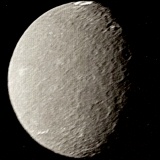 |
|
|
Montage
of Voyager images of Uranus and Umbriel.
|
|
| UMBRIEL - MOON OF URANUS | |
| Umbriel is a character in Alexander Popes' poem "The Rape of the Lock". Features on Umbriel are named after evil or dark spirits from world mythologies. Its discovery is normally attributed to William Lassell in 1851. However, William Herschel, who discovered Uranus as well as Titania and Oberon, may have found it 50 or 60 years earlier. | |
| Orbit | |
| Umbriel orbits 266,000 kilometres from Uranus and takes just over four days to complete its orbit. As with the other large moons of Uranus, Umbriel exhibits synchronous rotation - that is, it completes one rotation on its own axis for each revolution around Uranus. The orbit has a low eccentricity (0.005), making it nearly a perfect circle, and has a low inclination to Uranus' equatorial plane (0.36o). | |
 The orbits of Uranus' larger moons. |
|
| Physical properties | |
| Umbriel is 1170 kilometres across, slightly larger than Ariel, and the third largest of Uranus' moons. Of the large moons of Uranus, Umbriel is the least massive. | |
 Comparison between Umbriel and Earth's Moon. |
|
| Interior | |
| Umbriel has a low density (1400 kg m-3) , from which it is inferred that it contains a lot of water ice. It is estimated to be 40% ice, 60% rock. Most of the ice is quite likely located near the surface, mixed with a small amount of frozen methane. Its heavily cratered surface makes it appear a smaller version of Oberon. However, it lacks any fractures, scarps, or faults suggestive of internal activity. Nor is there surviving indication of volcanic activity involving ice. Umbriel may well have been active in its very early history, but there is little firm evidence. | |
| Magnetic field | |
| No magnetic field has been detected | |
| Atmosphere | |
| No atmosphere has been detected. | |
| Surface | |
| Pictures of Umbriel's surface were returned by Voyager 2 in 1986. As with the other moons, apart from Miranda, the resolution is low and the coverage poor | |
| Umbriel, with an albedo of 0.2, is the darkest of Uranus' satellites, although there are a few bright patches of clean ice excavated by impacts. These are not as prominent as those on Oberon. The surface layers may have more rocky fragments mixed with it. | |
 Voyager image of Umbriel taken at closest approach - 557,000 kilometres. |
|
| Umbriel, with an albedo of 0.2, is the darkest of Uranus' satellites, although there are a few bright patches of clean ice excavated by impacts. These are not as prominent as those on Oberon. The surface layers may have more rocky fragments mixed with it. | |
| The size distribution of craters is similar to Oberon's, but there is a greater proportion of large craters. This follows more closely the trend displayed by the lunar highlands. Craters range from 30 to 200 kilometres across. | |
| The most interesting structure on Umbriel is a large crater called Malingee, about 160 kilometres across, which has an unusually bright floor. This may have resulted from a large and fairly recent impact which enabled a surface of clean ice to form, melting the surface and enabling the rock debris to drop out from below. | |
|
|
|